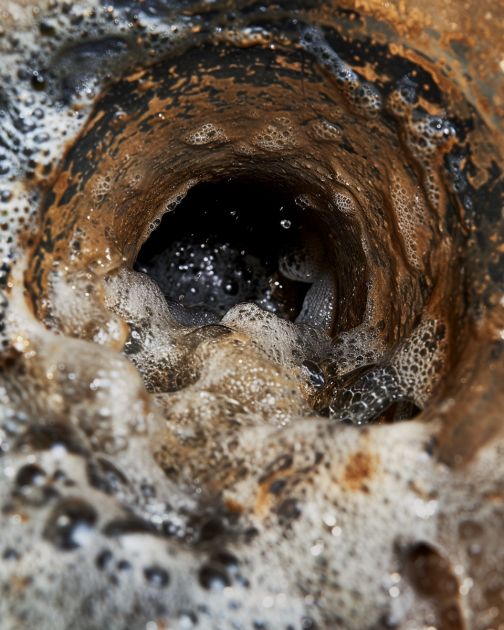The issue of clogged drains is a common household nuisance that can disrupt daily routines and lead to expensive repairs if not addressed promptly. This problem can be particularly perplexing in households with multiple occupants, such as families with children, where the source of the clog is not always immediately apparent. Understanding the potential causes can help homeowners take preventive measures and find effective solutions.
You might be wondering why this knowledge is necessary and what you can gain by reading further. This article delves into the often-overlooked causes of clogged drains, which can save you time, money, and the frustration of dealing with recurrent plumbing issues. Stay with us to uncover surprising sources of clogging you may have never considered.
Advertisement
Reasons You Might Not Have Considered
1. Soap Scum Buildup
Soap scum is a common but often overlooked cause of drain clogs. When soap mixes with the minerals in hard water, it creates a sticky residue that clings to the inside of pipes. Over time, this residue accumulates, narrowing the diameter of the pipe and eventually causing blockages.
How to Detect It:
Slow drainage over time.
Residue or a film around the drain.
Residue or a film around the drain.
Prevention and Solution:
Regularly clean the drains with a mixture of hot water, vinegar, and baking soda.
Use a water softener to reduce mineral content in your water.
Use a water softener to reduce mineral content in your water.
2. Toothpaste and Personal Care Products
Toothpaste, gels, lotions, and other personal care products can also contribute to drain clogs. These products can stick to the walls of pipes, especially if they contain thickening agents.
How to Detect It:
Similar signs to soap scum: slow drainage and residue around the drain.
A buildup of product residue around the sink or drain area.
A buildup of product residue around the sink or drain area.
Prevention and Solution:
Rinse the sink thoroughly after each use.
Use drain covers to catch any debris before it goes down the drain.
Use drain covers to catch any debris before it goes down the drain.
3. Accumulated Debris
Even if hairballs aren’t visible, small amounts of hair can still contribute to clogs when combined with other types of debris like dirt, dust, and skin flakes. This mixture can form a sticky mass that obstructs water flow.
How to Detect It:
Water pooling around the drain.
Gurgling sounds coming from the drain.
Gurgling sounds coming from the drain.
Prevention and Solution:
Install a hair catcher or strainer over the drain.
Regularly clean the drain cover and remove any trapped debris.
Regularly clean the drain cover and remove any trapped debris.
4. Food Particles and Grease
Although more common in kitchen sinks, food particles and grease can occasionally find their way into bathroom drains. Children, especially, might dispose of food or oily substances inappropriately.
How to Detect It:
Slow drainage and foul odors.
Visible particles around the drain.
Visible particles around the drain.
Prevention and Solution:
Avoid disposing of food and grease in bathroom sinks.
Clean drains with hot water and dish soap to dissolve grease.
Clean drains with hot water and dish soap to dissolve grease.
5. Foreign Objects
Children are known for their curiosity, and sometimes that means flushing or washing foreign objects down the drain. Small toys, paper, and other items can become lodged in the pipes.
How to Detect It:
Complete blockage of the drain.
Water backing up and overflowing.
Water backing up and overflowing.
Prevention and Solution:
Teach children what should and shouldn’t go down the drain.
Use drain covers to prevent small objects from being washed down.
Use drain covers to prevent small objects from being washed down.
6. Mineral Buildup
Hard water can cause mineral buildup in your pipes, leading to blockages. This is particularly problematic in areas with high levels of calcium and magnesium in the water supply.
How to Detect It:
Chalky white deposits around faucets and drains.
Gradual decrease in water flow.
Gradual decrease in water flow.
Prevention and Solution:
Install a water softener to reduce mineral content.
Regularly clean pipes with a vinegar solution to dissolve mineral deposits.
Regularly clean pipes with a vinegar solution to dissolve mineral deposits.
7. Plumbing Issues
Sometimes, the problem isn’t in the drain itself but in the plumbing system. Misaligned pipes, tree roots infiltrating the sewer line, or improperly installed plumbing can cause recurring clogs.
How to Detect It:
Recurring clogs even after cleaning the drain.
Multiple drains in the house clogging simultaneously.
Multiple drains in the house clogging simultaneously.
Prevention and Solution:
Have a professional plumber inspect your plumbing system.
Regular maintenance checks to identify and fix issues early.
Regular maintenance checks to identify and fix issues early.
8. Bacterial Growth
Biofilm, a slimy substance created by bacteria, can develop in drains, especially in homes with lots of water usage. This biofilm can trap other particles and lead to blockages.
Advertisement
How to Detect It:
Slow draining water and foul odors.
Slime or discoloration around the drain.
Slime or discoloration around the drain.
Prevention and Solution:
Use antibacterial drain cleaners.
Regularly pour boiling water down the drain to kill bacteria.
Regularly pour boiling water down the drain to kill bacteria.

